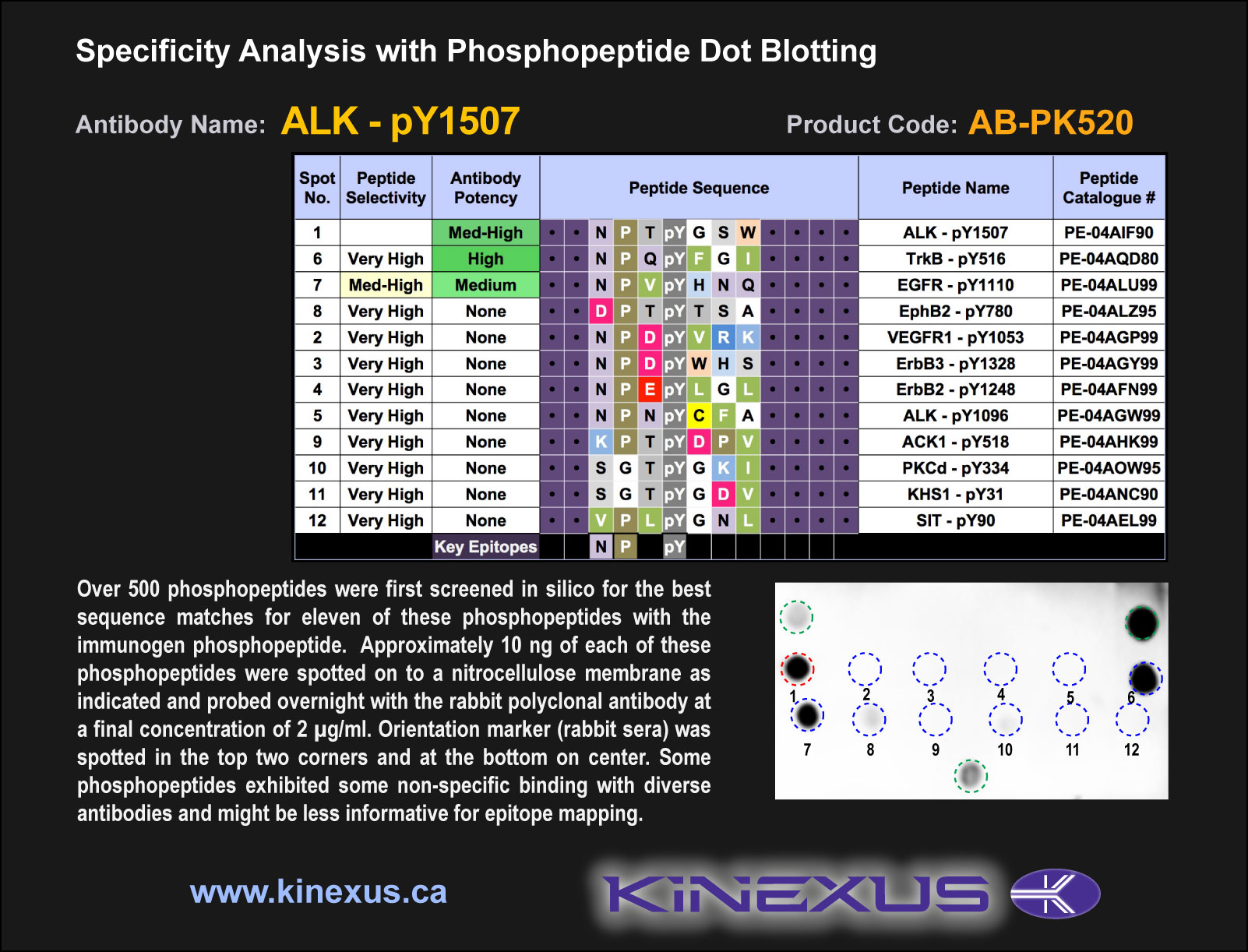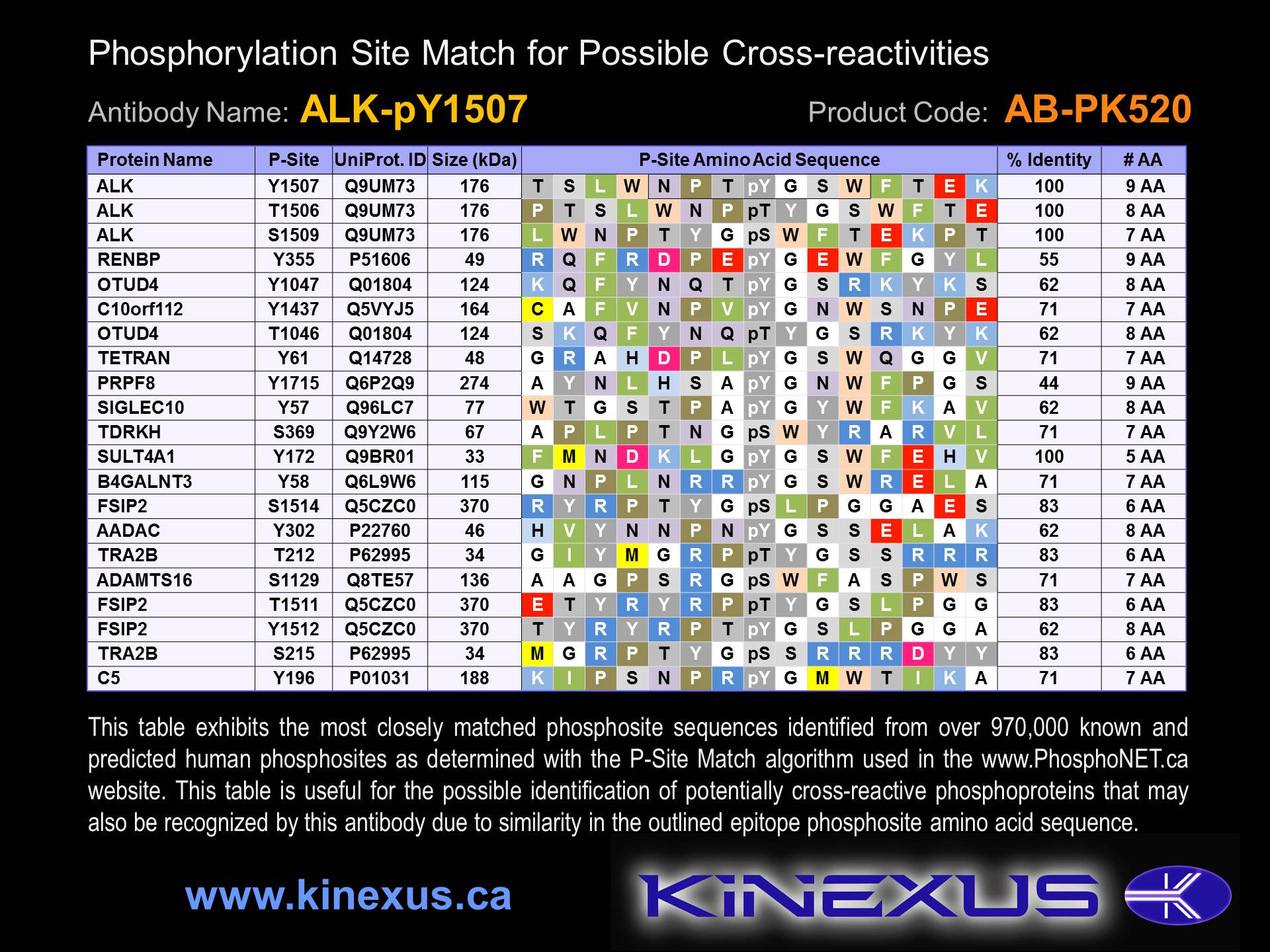Product Name: ALK-pY1507
Product Number: AB-PK520
| Size: | 25 µg | Price: | 89.00 | |
| $US |
Target Full Name: Anaplastic lymphoma receptor-tyrosine kinase
Target Alias: Anaplastic lymphoma kinase; Anaplastic lymphoma kinase (Ki-1); Anaplastic lymphoma receptor tyrosine kinase; CD246; Kinase ALK; TFG/ALK; ENSG00000171094
Product Type Specific: Protein kinase phosphosite-specific antibody
Antibody Code: PK520
Antibody Target Type: Phosphosite-specific
Antibody Phosphosite: Y1507
Protein UniProt: Q9UM73
Protein SigNET: Q9UM73
Antibody Type: Polyclonal
Antibody Host Species: Rabbit
Target Alias: Anaplastic lymphoma kinase; Anaplastic lymphoma kinase (Ki-1); Anaplastic lymphoma receptor tyrosine kinase; CD246; Kinase ALK; TFG/ALK; ENSG00000171094
Product Type Specific: Protein kinase phosphosite-specific antibody
Antibody Code: PK520
Antibody Target Type: Phosphosite-specific
Antibody Phosphosite: Y1507
Protein UniProt: Q9UM73
Protein SigNET: Q9UM73
Antibody Type: Polyclonal
Antibody Host Species: Rabbit
Antibody Immunogen Source: Human ALK sequence peptide Cat. No.: PE-04AIF90
Antibody Immunogen Sequence: NPT(pY)GSW(bA)C
Antibody Immunogen Description: Corresponds to amino acid residues N1504 to W1510; Near the C-terminus of the kinase after the catalytic domain
Antibody Immunogen Sequence: NPT(pY)GSW(bA)C
Antibody Immunogen Description: Corresponds to amino acid residues N1504 to W1510; Near the C-terminus of the kinase after the catalytic domain
Production Method: The immunizing peptide was produced by solid phase synthesis on a multipep peptide synthesizer and purified by reverse-phase hplc chromatography. Purity was assessed by analytical hplc and the amino acid sequence confirmed by mass spectrometry analysis. This peptide was coupled to KLH prior to immunization into rabbits. New Zealand White rabbits were subcutaneously injected with KLH-coupled immunizing peptide every 4 weeks for 4 months. The sera from these animals was applied onto an agarose column to which the immunogen peptide was thio-linked. Antibody was eluted from the column with 0.1 M glycine, pH 2.5. Subsequently, the antibody solution was neutralized to pH 7.0 with saturated Tris.This antibody was also subject to negative purification over phosphotyrosine-agarose.
Antibody Modification: Unconjugated. Contact KInexus if you are interest in having the antibody biotinylated or coupled with fluorescent dyes.
Antibody Modification: Unconjugated. Contact KInexus if you are interest in having the antibody biotinylated or coupled with fluorescent dyes.
Antibody Concentration: 1 mg/ml
Storage Buffer: Phosphate buffered saline pH 7.4, 0.05% Thimerasol
Storage Conditions: For long term storage, keep frozen at -40°C or lower. Stock solution can be kept at +4°C for more than 3 months. Avoid repeated freeze-thaw cycles.
Product Use: Western blotting | Antibody microarray
Antibody Dilution Recommended: 2 µg/ml for immunoblotting
Antibody Potency: Strong immunoreactivity with immunogen peptide on dot blots.
Antibody Species Reactivity: Human
Antibody Positive Control: The observed molecular mass of the processed target protein on SDS-PAGE gels is reported to be around 140-170 kDa.
Storage Buffer: Phosphate buffered saline pH 7.4, 0.05% Thimerasol
Storage Conditions: For long term storage, keep frozen at -40°C or lower. Stock solution can be kept at +4°C for more than 3 months. Avoid repeated freeze-thaw cycles.
Product Use: Western blotting | Antibody microarray
Antibody Dilution Recommended: 2 µg/ml for immunoblotting
Antibody Potency: Strong immunoreactivity with immunogen peptide on dot blots.
Antibody Species Reactivity: Human
Antibody Positive Control: The observed molecular mass of the processed target protein on SDS-PAGE gels is reported to be around 140-170 kDa.
Antibody Specificity: Very high
Antibody Cross Reactivity: No significant cross-reactive proteins detected in T98G, A431, and Jurkat cells, and seastar oocytes.
Related Product 1: ALK-pY1507 blocking peptide
Related Product 2: ALK-AKCD pan-specific antibody (Cat. No.: AB-NK003-2)
Related Product 3: ALK-BKCD pan-specific antibody (Cat. No.: AB-NK003-3)
Related Product 4: ALK-pY1092 phosphosite-specific antibody (Cat. No.: AB-PK518)
Related Product 5: ALK-pY1096 phosphosite-specific antibody (Cat. No.: AB-PK519)
Antibody Cross Reactivity: No significant cross-reactive proteins detected in T98G, A431, and Jurkat cells, and seastar oocytes.
Related Product 1: ALK-pY1507 blocking peptide
Related Product 2: ALK-AKCD pan-specific antibody (Cat. No.: AB-NK003-2)
Related Product 3: ALK-BKCD pan-specific antibody (Cat. No.: AB-NK003-3)
Related Product 4: ALK-pY1092 phosphosite-specific antibody (Cat. No.: AB-PK518)
Related Product 5: ALK-pY1096 phosphosite-specific antibody (Cat. No.: AB-PK519)
Scientific Background: ALK is a protein-tyrosine kinase of the TK group and ALK family. It is a neuronal receptor for the ligands pleiotrophin (PTN), a secreted growth factor, and midkine (MDK), a PTN-related factor. ALK signals via MyD88 and is important in neuronal differentiation and development. Cancer-related mutations in human tumours point to a gain of function of the protein kinase. The active form of the protein kinase normally acts to promote tumour cell proliferation. Chromosomal rearrangments (most common), mutations, and amplifications with the ALK gene are associated with numerous tumours including: anaplastic large cell lymphomas, neuroblastomas, and non-small cell lung cancer. These fusion proteins, as well as other mutations and amplifications, likely confer heightened (possibly consititutive) phosphotransferase activity and promote cell growth and anti-apoptotic pathways such as the Akt and MAPK pathways. In Neuroblastoma 3 (NBLST3), there was constitutive activation, and Endoplasmic Reticulum or Golgi Apparatus localization when ALK had gain of function mutations with F1174I or F1174V (located in the kinase catalytic subdomain III) or R1275Q (located just before the kinase catalytic Subdomain VII). Translocations of the ALK gene resulting in fusion proteins with NPM1 are observed in 5-10% of non-Hodgkin lymphomas, with CARS and SEC31A in inflammatory myofibroblastic tumours (IMTs) and ALO17 in anaplastic large-cell lymphoma (ALCL). The genes C/EBPB, and BCL2A1 are essential for ALCL growth and transcriptionally induced by ALK.
Figure 1. Epitope mapping of ALK-pY1507 antibody with similar phosphopeptides on dot blots.
Figure 2. Identification of phosphosites related to ALK-pY1507.
© Kinexus Bioinformatics Corporation 2017



